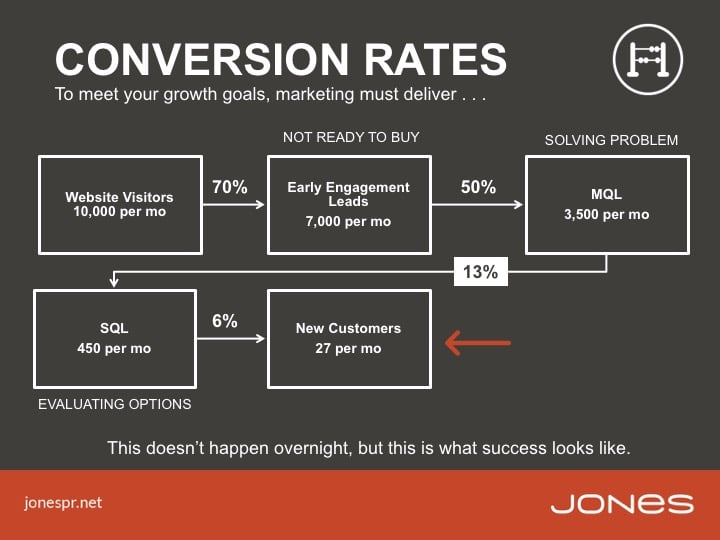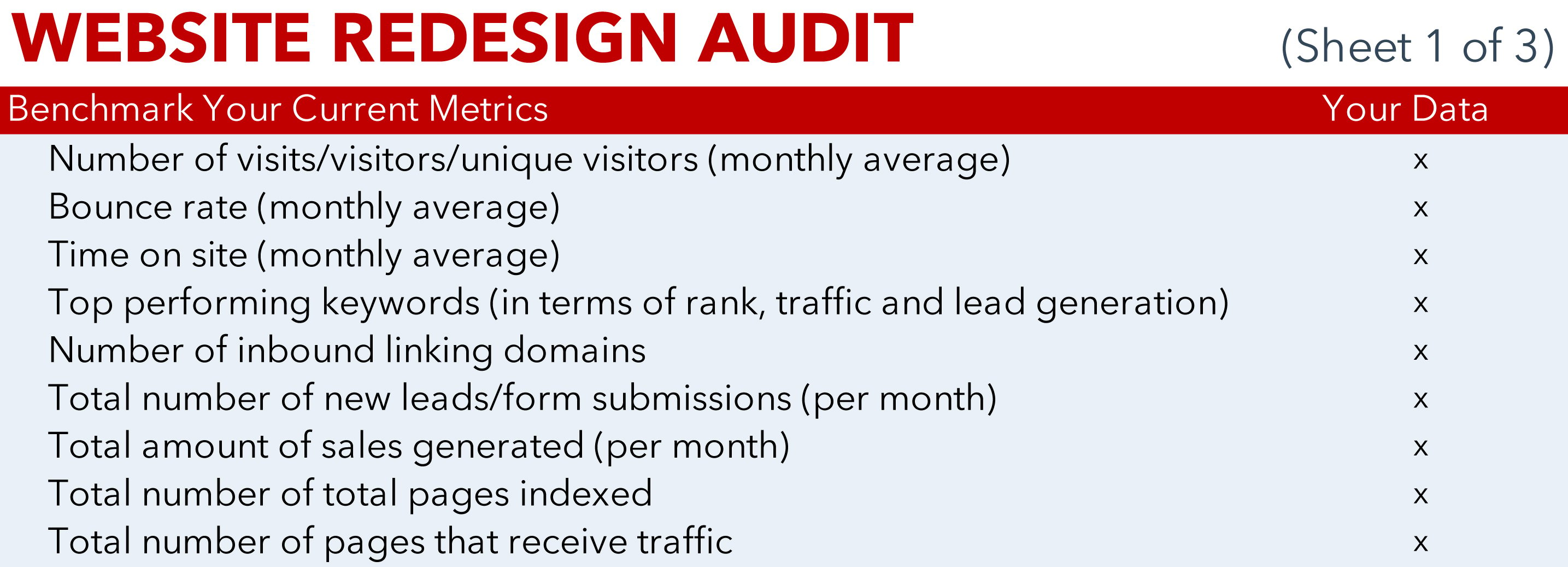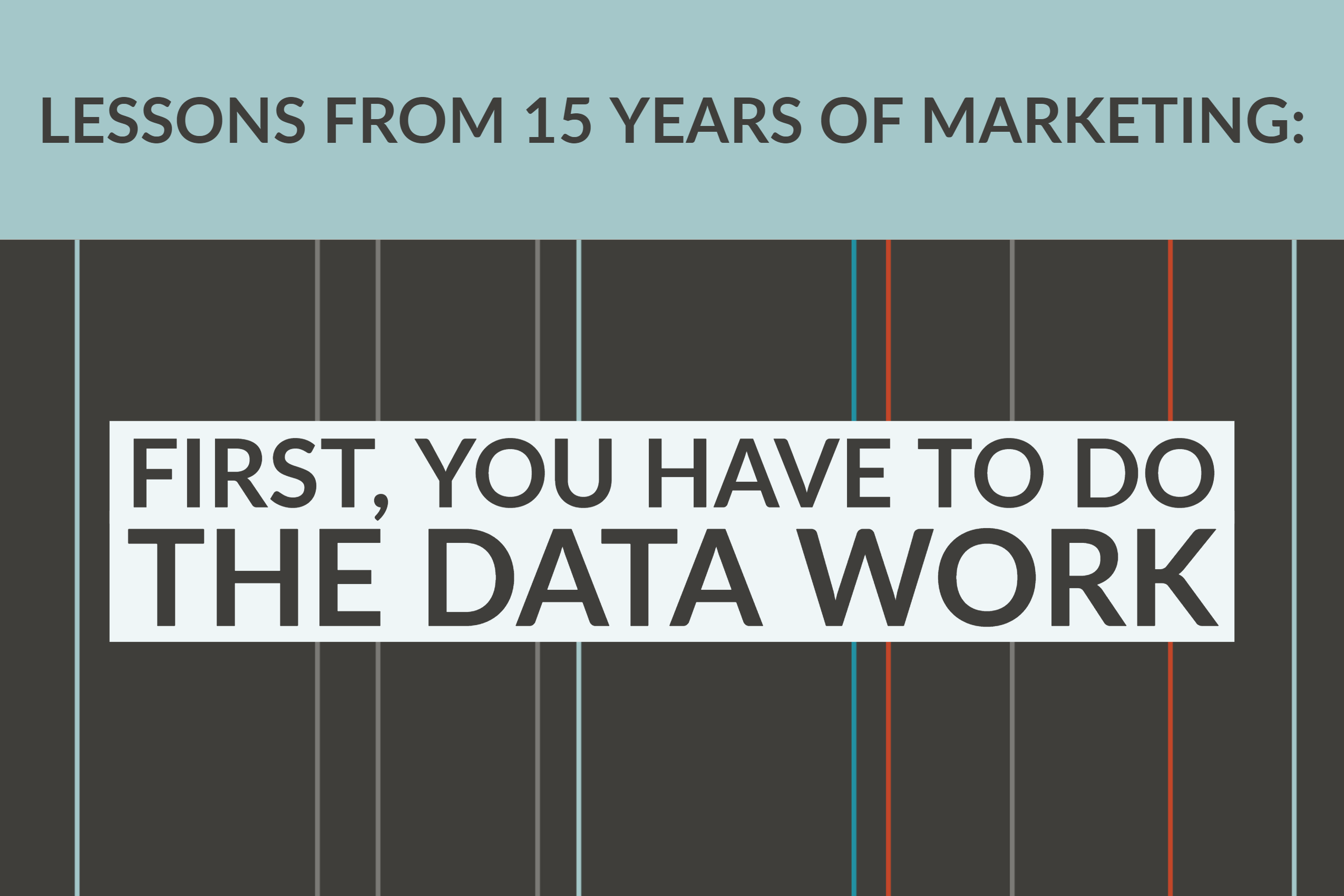Lessons From 15 Years: First, You Have To Do The Data Work

In some professions, you have to do the dirty work to set up a project for success. Building the tallest skyscraper begins with making sure the ground is prepped and a solid foundation in place. Creating the most delectable dessert begins with making a mess in the kitchen. It takes some dirty work before the genius can be seen.
In marketing, it’s not so much dirty work as it is data work.
You may think marketing is about big ideas, creativity, artistic and social savvy. But first, it has to be about the numbers.
Doing the data work isn’t necessarily easy, but it is essential in order to set meaningful objectives, create the best campaigns possible, continually improve, and prove your worth (therefore backing up your budget requests) to the executive suite.
____________________________________________________________________
This post is one in a 15-part series looking back at the lessons learned in my 15 years as founder and owner of JONES Marketing & PR. Find the two most recent posts in the series here:
-
Lessons From 15 Years: Expertise Essential For Marketing Within The Life Sciences Field
-
Lessons From 15 Years: Integrate Marketing & PR To Reach Healthcare IT Decision-Makers
____________________________________________________________________
My Marketing Lesson #10: Taking time to do the data work—establishing benchmarks and goals, tracking metrics, auditing existing programs, and reporting results—is essential to improving marketing performance and proving marketing’s value to the executive suite.
While the most visible part of an integrated marketing program is the creative content and concrete deliverables — websites, videos, advertising, contributed articles, social media content — it is the behind-the-scenes analysis that sets the stage for those elements to achieve the desired results. Before you start planning a marketing or PR campaign or program, you must first do the data work.
1. You need to know where you stand before you start.
The first step in doing the data work is collecting the data that tells you where your marketing and sales performance metrics stand today. The ability to refer to what you are currently doing, and how well it is working, is essential in order to determine your next steps that will improve on current performance.
There are many key performance indicators (KPIs) you should document. You will want to determine KPIs that impact – or are important to – several different stakeholders: executive management, the marketing team, the sales team, and any agency partner you are working with.
This graphic shows the top 10 recommended KPIs for each team, but there may be more you will want to include.
![]()
Along with these performance indicators, detail your current campaigns:
-
How many campaigns do you do each year?
-
What does each campaign include?
-
How many leads does each campaign generate?
-
How many website visitors do you get each month?
-
How many calls-to-action are on your website?
-
What is your visitor-to-lead conversion rate?
According to the HubSpot Demand Generation Report based on findings from a survey of more than 900 marketers, the less companies know about their KPIs, the less likely they are to meet their revenue goals – 74 percent of companies that weren’t exceeding revenue goals did not know their visitor, lead, MQL, or sales opportunities.
The more data you have around what you are doing now, the more prepared you will be to take the next step.
2. Use today's benchmarks and corporate objectives to set specific marketing targets.
Starting with the data you collected on the KPIs and questions listed above, you next outline what your corporate objectives are in terms of revenue growth, and working backwards, determine what that level of growth requires in terms of sales, qualified leads, early engagement leads and website traffic.

While this slide shows industry standard conversion rates for B2B businesses, your own industry and individual company may have different rates — check above in the data you collected for your KPIs. Then work backward from the corporate sales and revenue objectives to determine what level of website traffic and interaction your marketing and public relations campaigns need to drive.
1. How many new customers do you need each month?
2. How many sales-qualified leads are typically needed to achieve that many closed sales?
3. How many marketing-qualified leads are needed to yield that many sales-qualified leads?
4. How many early engagement leads are needed for the necessary MQLs?
5. How much website traffic is necessary to generate that number of early engagement leads?
Phew! That’s a lot of math. But now you have a concrete objective to work toward.
Want another look at how this process works? I recently developed this video to walk you through the process of doing the math.
3. Audit existing tools before making changes.
With your new goal in hand, you’re ready to begin planning that new campaign or designing a new website, right?
Sorry, there is still more data work to do, if you want to improve what you already have rather than just changing it. Your next project will be more effective if you audit your existing tools before creating new ones.
While we do a number of different audits for our clients (check out our comprehensive checklist here), the three most pertinent to doing the data work to inform marketing strategies and campaigns are marketing success audits, marketing content audits and website audits.
A marketing success audit will review many of the same KPIs and metrics listed in the first point above, including:
-
Current reach via:
-
Website traffic
-
Blog readership
-
Social media – paid and organic
-
-
Inbound marketing lead generation
-
Lead nurturing
-
Close rates
-
Lead qualification and collaboration with sales
-
-
Metrics
-
What metrics are being tracked and used?
-
-
Revenue
-
Are revenue goals being met?
-
Your marketing content audit should be an inventory meant to identify gaps in your content: Do you have enough content across all channels, targeting all customer personas, and designed for all stages of the sales funnel? This type of audit should include:
-
Types of content developed and used
-
Topics covered
-
Stages of the sales funnel included in content strategy
-
Customer personas targeted with specific content
-
Utilization of calls-to-action and landing pages that drive lead generation
If you are specifically considering a website update, then your current website deserves scrutiny to determine what is working well and where improvements can be made. Understanding your baseline, and the website that has yielded those results, is an important step in creating the website that can achieve your desired results in the future.
Take the time to score your current website (or invest in the time and experience of an agency that can do so with an objective perspective) on the elements outlined in these template pieces (download the template here).



4. Report performance to prove value and validate budget requests.
Once you’ve gathered all of your baseline data, extrapolated to determine what benchmarks you need to achieve in order to reach corporate goals, and created an integrated public relations and marketing strategy with the deliverables needed for that level of performance (more on the concept of integrated marketing and PR coming in my next “lessons” post!), you finally get to sit back and leave the data and math behind.
Just kidding!
Did I make it sound at the beginning of this article like you only have to do the data work once, and then move on? Sorry if that was the impression. Because doing the data work is a constant part of a marketing manager or CMO’s job.
Tracking metrics to measure performance, and then reporting those results to your team, your colleagues in sales, and executive management is an essential step in proving the value of marketing’s efforts. We know it isn’t easy. In fact, “proving ROI” is consistently tops the list of challenges in HubSpot’s annual State of Inbound report. But it is worth the effort.
Check out the metrics you can keep tabs on in HubSpot, just for your
blog: A Tour Of HubSpot’s Measuring Tools. This just scratches the surface.
Your marketing team will want to track this and more, including website
metrics and individual landing page conversion rates.
Executive management may not want to see the nitty-gritty details of every specific metric you track to help your own decision making in the future.
What the executive suite may want to know are the basics, and how they are changing, including:
-
Marketing reach by channel
-
Website visits by month
-
New customers by source
-
Customers generated by marketing efforts
-
Visitor-to-lead performance
-
Lead-to-customer performance
-
Visitor-to-customer performance
And they are certain to appreciate your attention to the overall goals of the company when you can provide these bottom-line oriented metrics:
-
Customer acquisition cost
-
Marketing’s share of customer acquisition cost
-
Ratio of customer lifetime value to customer acquisition cost
-
Time to pay back customer acquisition cost
-
Marketing originated customer percentage
-
Marketing influenced customer percentage
Not sure how to calculate those 6 Metrics Your Boss Actually Cares
Having a solid grasp on your numbers and how they impact the company’s bottom line in terms of revenue generated, as well as what it costs your team to develop the deliverables that yield those results, is essential when you submit your budget requests. After all, you need to be able to make reasonable commitments that your team can achieve certain results, but only when they have the necessary resources. You can’t triple lead generation on a 10 percent increase. Yes, a better approach and optimizing your efforts can increase performance on a similar budget, but if your team is expected to deliver significant growth, you need to request a larger budget and back up that request with data that shows the executive team where you’re at now and what it will take to get you to where you need to be.
Understanding the data can give you as the CMO the confidence to say, “What we can deliver to you, based on the budget we have today, is X leads. But you need Y leads, so there is a gap that sales will have to prospect and cold-call for, unless we get the budget needed to develop the content/channels/campaigns required.”
Those four steps represent a lot of work, I know. Can a marketing plan and campaign be developed without doing the data work? Sure, many are. But many marketing plans fail to deliver results, because there was no preparation done in advance to understand baselines, objectives, and the necessary deliverables and budget to achieve those objectives.
Doing the data work is the difference between marketing and effective marketing strategies that prove their value. Are you willing to do the work? Or to invest in having someone do the data work for you, so that you know how best to invest your budget?
Doing the data work is just one of the lessons I’ve learned in my 15 years as an agency owner (and many more years in marketing and PR before starting up JONES). While I know it isn’t the most fun part of the job, I sincerely believe it is essential, which is why I have dedicated one of my 15 lessons articles to the topic. I am equally committed to the idea that we need to take an integrated approach to marketing and public relations, which is what I will cover in the next post in this 15-part series. If you’ve missed earlier installments, you can find them all here. Subscribe to the Inbound Accelerator and you’ll get the rest of them delivered right to your inbox. We can all continue to learn.
-1.png?width=1652&height=294&name=Jones(RGB)-1.png)










.png?width=352&name=How%20To%20Use%20Surveys%20To%20Fuel%20Your%20Content%20Marketing%20Strategy%20(video).png)

